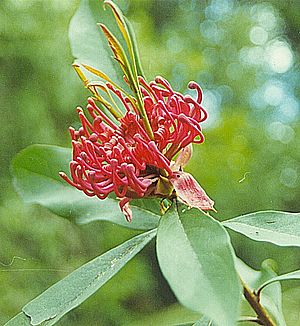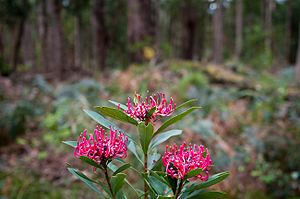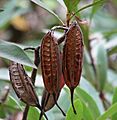Gippsland waratah facts for kids
Quick facts for kids Gippsland waratah |
|
|---|---|
 |
|
| Scientific classification | |
| Genus: |
Telopea
|
| Species: |
oreades
|
 |
|
| Range in southeastern Australia (in red) | |
| Synonyms | |
|
Hylogyne oreades (F.Muell.) Kuntze |
|
The Gippsland waratah (Telopea oreades) is a large shrub or small tree. It is also known as the mountain or Victorian waratah. This plant belongs to the Proteaceae family. It grows naturally in southeastern Australia. You can find it in wet forests and rainforests. It likes rich, acidic soils that have lots of organic matter.
This waratah can grow up to 19 meters (62 feet) tall. It usually has one main trunk and grows straight up. Its leaves are dark green with clear veins. They are about 11 to 28 cm (4.3 to 11 in) long. The bright red flower heads appear in late spring. Each flower head has up to 60 individual flowers.
People grow the Gippsland waratah in gardens. It needs soil that drains well and stays moist. It can grow in sunny spots or places with some shade. There are also special types of waratahs called cultivars. These are mixes of the Gippsland waratah and another type, the New South Wales waratah. The wood from this tree is hard. It has been used to make furniture and tool handles.
Contents
What the Gippsland Waratah Looks Like

The Gippsland waratah can grow as a big shrub or a tall, thin tree. It reaches 9 to 19 meters (30 to 62 ft) high. Its trunk can be 45 to 60 cm (18 to 24 in) wide. The trunk is grayish-brown and smooth. It has small bumps and lines called lenticels. These help the tree breathe.
Young plants grow very straight. Their stems often have a reddish color. The shiny, dark green leaves grow one after another along the stems. They are shaped like a spoon or a narrow oval. They are 11 to 28 cm (4.3 to 11 in) long and 1.5 to 6 cm (0.59 to 2.4 in) wide. The main vein on the top of the leaf is sunken. On the underside, it forms a ridge. There are also four to six pairs of side veins.
Flowers and Seeds
The Gippsland waratah flowers from October to December. Plants growing higher up in the mountains flower later. The bright red flower heads are about 9 cm (3.5 in) wide. They have 36 to 60 individual flowers. Green to pink leaf-like structures called bracts surround the flowers. These can be up to 3 cm (1.2 in) long.
Each flower has a red outer part called a perianth. It is about 2.5 cm (1 in) long. The flowers open from the center of the flower head outwards. Each flower has a part that makes pollen (the stamen). It also has a part that receives pollen (the stigma) at the end of a stalk called the style. The part that holds the seeds (the ovary) is at the base of the style. A small, crescent-shaped part that makes sweet liquid (the nectary) is also there.
After flowering, curved, leathery seed pods grow. These pods are 5 to 7.5 cm (2.0 to 3.0 in) long. They look a bit like a boat. They ripen between May and September of the next year. Then they split open and release 10 to 16 seeds. The seeds are flat, brown, and have a wing. They are about 1 cm (0.39 in) long. The wing is about 3.5 to 4 cm (1.4 to 1.6 in) long. New shoots often grow right through the old flower heads.
It can be tricky to tell the Gippsland waratah apart from the Braidwood waratah (Telopea mongaensis). However, the Braidwood waratah usually has narrower leaves. Also, the Gippsland waratah flowers about a month earlier.
Where the Gippsland Waratah Grows
The Gippsland waratah lives in wet forests and cool rainforests. It grows in two separate areas of southeastern Australia. One area is in East Gippsland in Victoria. It stretches from Orbost to Eden in southern New South Wales. The other area is further north. It is around the Monga Valley near Braidwood, New South Wales.
These plants like wet eastern and southern slopes. They grow where the yearly rainfall is between 1000 and 2000 mm (39 and 79 in). They prefer acidic soil that has many nutrients and lots of organic matter. Other trees often found with the Gippsland waratah include shining gum, messmate, and mountain grey gum.
Protecting the Species
The Gippsland waratah is not currently listed as rare or threatened. However, it grows in a special type of cool temperate rainforest. This rainforest community is protected in Victoria. Also, planted waratah trees are sometimes stolen from nature areas. This is because they are popular garden plants.
How the Gippsland Waratah Lives (Ecology)
The bright red flowers of the Gippsland waratah are very noticeable. This suggests that birds help to pollinate them. Birds visit the flowers to drink their sweet nectar. Birds like the red wattlebird, eastern spinebill, and silvereye have been seen visiting these flowers.
The Gippsland waratah has a main root that goes deep into the ground. It also has special roots called proteoid roots. These roots have many tiny rootlets that form a dense mat. They are very good at taking in nutrients from poor soils. This includes soils that don't have much phosphorus.
This plant has a swollen, woody base under the soil called a lignotuber. This lignotuber stores energy and nutrients. It helps the plant grow back quickly after a bushfire. The wet forests where it grows do not often catch fire. But if a fire happens, new shoots can grow from the lignotuber. Seeds also sprout well after a fire. This is because the soil has more nutrients and fewer competing plants.
Growing and Using the Gippsland Waratah
The Gippsland waratah needs soil that drains well. But it also needs to stay moist. Soil with some clay can be helpful. It can handle more shade than the New South Wales waratah. It prefers some shade but can also grow in sunny spots. It can also handle moderate frosts.
You can prune these plants hard. Cutting back old stems can help older plants grow new, strong parts. Giving them a special fertilizer (low in phosphorus) in spring and autumn can help them too. You can grow new plants from seeds. But seeds don't last long unless they are kept cold. You can also grow new plants from cuttings.
Special Types (Cultivars)
People have created several special types (called hybrids) of the Gippsland waratah. They crossed it with the New South Wales waratah. They wanted to combine the Gippsland waratah's toughness with the New South Wales waratah's showier flowers. You can find red, pink, and even white-flowered types.
Here are some examples:
- Telopea 'Champagne' has creamy yellow flowers. It is a mix of three different waratah types.
- Telopea 'Golden Globe' is bigger than 'Champagne'. It also has creamy yellow flowers. It is sold as 'Shady Lady Yellow'.
- Telopea 'Shady Lady Red' is a larger shrub. It can grow up to 5 meters (16 ft) high. It is a mix of the Gippsland waratah and the New South Wales waratah. It can handle more shade.
- Telopea 'Shady Lady White' is a white-flowered mix of the two waratah types.
- Telopea 'Shady Lady Pink' is a cross between 'Shady Lady Red' and 'Shady Lady White'.
- Telopea 'Shady Lady Crimson' is a special red color from 'Shady Lady Red'.
Timber Uses
The wood from the Gippsland waratah is quite hard. It is similar to silky oak wood. It lasts a long time and can be polished easily. This makes it good for making furniture, picture frames, and tool handles.
Images for kids
-
Open follicles following release of seeds






